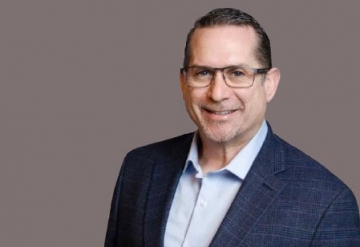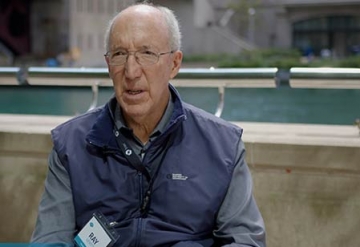THANK YOU FOR SUBSCRIBING

Singularity, AI and Spatial Computing: Tales from the Field
Paul Doherty, IFMA Fellow, DFC Senior Fellow, President and CEO, the digit group, Inc

 Paul Doherty, IFMA Fellow, DFC Senior Fellow, President and CEO, the digit group, Inc
Paul Doherty, IFMA Fellow, DFC Senior Fellow, President and CEO, the digit group, IncPaul is Managing Partner of The Digit Group, Inc. TDG (www.thedigitgroupinc.com), a Singapore-registered Smart City real estate development and investment company. As seen on Bloomberg TV and The Wall Street Journal, CNBC acknowledged Paul as one of America’s business titans and reported by Forbes as “Changing the World.” Paul is an award-winning architect, a Senior Fellow of the Design Futures Council and a Fellow of the International Facility Management Association (IFMA). Concurrently, Paul co-founded and produced the critically acclaimed AEC Hackathon (www.aechackathon.com). His two latest books are “Smart Cities: Reimagining the Urban Experience” published by Quality Press and “Unlocking the Metaverse: A Strategic Guide for the Future of the Built Environment,” published by John Wiley & Sons, which rated #1 New Release and an Editor’s Pick on Amazon.com.
Merging AI and Design for Sustainable Construction Futures
Singularity is when Artificial Intelligence (AI), Spatial Computing and Humans merge into a singular process entity that creates opportunities for humans to have superhero powers in business and their lives. Construction is colliding with this new reality. The link between Singularity and the Circular Economy lies in their collective ability to transform how we manage and interact with physical spaces.
As it approaches Singularity, AI can drive innovations in spatial computing and architecture, leading to more efficient, sustainable and circular practices. Spatial computing enhances our ability to manage and optimize spaces, while proper design ensures that these spaces are run sustainably, aligning with the principles of the circular economy. Together, these technologies, processes and practices enable a future where buildings and infrastructure are more intelligent, efficient and sustainable, contributing to a circular economy. Here are scenarios of the design and construction implementation of Singularity.
Building Design for Safety and Accessibility
Application: Considering universal design, Singularity provides design principles and compliance guidance on ADA accessibility standards, ensuring that structures are safe and accessible for individuals of all abilities. For example, recommendations on ramp gradients, doorway widths and tactile indicators could prevent falls and ensure safe egress for everyone.
Impact: Integrating accessible design from the start avoids costly retrofits and promotes inclusivity, directly impacting public welfare by making spaces usable and safe for a diverse population.
Structural and Material Safety
Application: By discussing building codes, material selection and structural integrity, Singularity provides insight into choosing fire-resistant materials, proper load-bearing techniques and sustainable construction practices. For instance, recommending fire-resistant gypsum boards in high-traffic areas or specifying materials that reduce flammability in exit corridors can minimize the risk in emergencies.
“The convergence of AI, spatial computing and human insight is revolutionizing construction, enabling smarter, safer and more sustainable buildings while transforming the industry into a data-driven, efficient ecosystem that enhances public welfare and redefines design possibilities”
Impact: Reducing fire hazards, enhancing structural stability and preventing collapse in adverse events like earthquakes can save lives and protect occupants’ safety.
Environmental Health through Sustainable Design
Application: Focusing on sustainable practices, Singularity provides green building strategies, such as optimizing natural ventilation, choosing low-VOC materials and implementing energyefficient lighting. This could include using insulated glazing to prevent heat loss or designing layouts that reduce exposure to harmful substances.
Impact: These measures can improve indoor air quality, reduce greenhouse gas emissions and lower energy consumption, positively affecting public health and environmental welfare.
Resilience and Disaster Preparedness
Application: When addressing topics like disaster-resistant design, Singularity shares best practices for designing buildings to withstand natural disasters—such as floodresilient foundations in flood-prone areas or hurricane shutters for wind protection. Advice on using reinforced concrete, proper drainage systems and elevated construction can mitigate disaster impacts.
Impact: Building structures with disaster resilience not just protects lives and assets but ensures community continuity and faster recovery after significant events.
Energy and Resource Efficiency
Application: Singularity provides insights into implementing energyefficient technologies and resourcesaving practices, such as rainwater harvesting or solar panel integration.
Impact: Reducing energy consumption and conserving resources benefits public welfare by contributing to environmental sustainability and cost savings, which can be redirected to improve other health, safety and welfare aspects.
Having precise, actionable information can make a significant difference in these scenarios. Implementing these practices can reduce risks, ensure regulatory compliance, improve resilience and promote sustainable development, all of which enhance the general public’s health, safety and welfare.
When Singularity, AI and Spatial Computing converge, our industry can expect the following outcomes:
Convergence leads to Construction 5.0: a data-driven, automated and intelligent ecosystem in which buildings design, construct and maintain themselves with human oversight.
Sustainability and efficiency: Reduced waste, better energy performance and optimized resource use through AI-led modeling and innovative materials.
Economic disruption: Traditional business models will collapse or transform as digital-first, AI-integrated workflows become standard.
Mass customization: AI and robotics can fabricate custom buildings quickly and affordably, enabling tailored design at scale.
Read Also
Development of the Logistics Warehousing Market in Brazil
Driving Innovation and Preserving Tradition
Operational Leadership VS Field Leadership in the Utility Construction Business
People-First Innovation: Developing Virtual Design and Construction (VDC) Training Programs to Empower Field Team Members
Sustainable Projects: Aligning Business and Purpose in Latin America
Engage Smarter: Why Constraints Matter More Than Hazards

 Copyright © 2025 All Rights Reserved | by:
Copyright © 2025 All Rights Reserved | by: Construction Tech Review
| Subscribe | About us | Sitemap| Editorial Policy| Feedback Policy


![Ramon Parchment, Project Manager, AECOM Tishman [NYSE: ACM] Bridging the Gap: How Artificial Intelligence (A.I.) Can Revolutionize Procurement in Construction](https://www.constructiontechrevieweurope.com/newstransfer/upload/360x247_C0AG.jpg)











